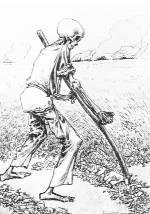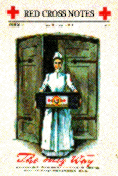Welcome to the First Annual
ALL AMERICAN FITNESS EPIDEMIC
How many people in the world are effected by Epidemics?
How many people die on average from an Epidemic or Pandemic?
The Influenza Pandemic of 1918
The influenza pandemic of 1918-1919 killed more people
than the Great War, known today as World War I (WWI), at somewhere between
20 and
40 million people. It has been cited as the most devastating epidemic in
recorded world history. More people
died of influenza in a single year than in four-years of the Black Death
Bubonic Plague from 1347 to 1351. Known as "Spanish Flu" or "La
Grippe" the influenza of 1918-1919 was a global disaster.

The Grim Reaper by Louis Raemaekers
In the fall of 1918 the Great War in Europe was winding down and peace
was on the horizon. The Americans had joined in the fight, bringing the
Allies closer to victory against the Germans. Deep within
the trenches these men lived through some of the most brutal conditions of
life, which it seemed could not be any worse. Then, in pockets across the
globe, something erupted that seemed as benign as the common cold. The
influenza
of that season, however, was far more than a cold. In the two years
that this scourge ravaged the earth, a fifth of the world's population
was infected. The flu was most deadly for people ages 20 to 40. This
pattern of morbidity was unusual for influenza which is
usually a killer of the elderly and young children. It infected 28% of
all Americans (Tice). An estimated 675,000 Americans died of influenza
during the pandemic, ten
times as many as in the world war. Of the U.S. soldiers who died in
Europe, half of them fell to the influenza virus and not to the enemy
(Deseret News). An estimated 43,000 servicemen mobilized for WWI died of
influenza (Crosby). 1918 would go down as unforgettable year of suffering
and death and yet of peace. As noted in the Journal of the American
Medical Association final edition of 1918:
"The 1918 has gone: a year momentous as the
termination of the
most cruel war in the annals of the human race; a year which marked, the
end at least for a time, of man's destruction of man; unfortunately a year
in which developed a most fatal infectious disease causing the death of
hundreds of thousands of human beings. Medical science for four and
one-half years devoted itself to putting men on the firing line and
keeping them there. Now it must turn with its whole might to combating
the greatest enemy of all--infectious disease," (12/28/1918).However, a first wave of influenza appeared early in the spring of 1918 in
Kansas and in military camps throughout the US. Few noticed the epidemic
in the midst of the war. Wilson had just given his 14 point address. There
was virtually no response or acknowledgment to the epidemics in March and
April in the military camps. It was unfortunate that no steps were taken
to prepare for the usual recrudescence of the virulent influenza strain in the winter. The lack of action was
later criticized when the epidemic could not be ignored in the winter of
1918 (BMJ, 1918). These first epidemics at training camps were a sign of
what was coming in greater magnitude in the fall and winter of 1918 to the
entire world.
The war brought the virus back into the US for the second wave of the
epidemic. It first arrived in Boston in September of 1918 through the port
busy with war shipments of machinery and supplies. The war also enabled
the virus to spread and diffuse. Men across the nation were mobilizing to
join the military and the cause. As they came together, they brought the
virus with them and to those they contacted. The virus killed almost
200,00 in October of 1918 alone. In November 11 of 1918 the end of the
war enabled a resurgence. As people celebrated Armistice Day with parades
and large partiess, a complete disaster from the
public health standpoint, a rebirth
of the epidemic occurred in some cities. The flu that winter was beyond
imagination as
millions were infected and thousands died. Just as the war had effected
the course of influenza, influenza affected the war. Entire fleets were
ill with the disease and men on the front were too sick to fight. The
flu was devastating to both sides, killing more men than their own
weapons could.
 With the military patients coming home from the war with battle
wounds and mustard gas burns, hospital facilities and staff were taxed to
the limit. This created a shortage of physicians, especially in the
civilian sector as many had been lost for service with the military.
Since the medical practitioners were away with the troops, only the
medical students were left to care for the sick. Third and forth year
classes were closed and the students assigned jobs as interns or nurses
(Starr,1976). One
article noted that "depletion has been carried to such an extent that the
practitioners are brought very near the breaking point," (BMJ, 11/2/1918).
The shortage was further confounded by the added loss of physicians to the
epidemic. In the U.S., the Red Cross had to recruit more
volunteers to contribute to the new cause at home of fighting the
influenza epidemic. To respond with the fullest utilization of nurses,
volunteers and medical supplies, the Red Cross created a National
Committee on Influenza.
With the military patients coming home from the war with battle
wounds and mustard gas burns, hospital facilities and staff were taxed to
the limit. This created a shortage of physicians, especially in the
civilian sector as many had been lost for service with the military.
Since the medical practitioners were away with the troops, only the
medical students were left to care for the sick. Third and forth year
classes were closed and the students assigned jobs as interns or nurses
(Starr,1976). One
article noted that "depletion has been carried to such an extent that the
practitioners are brought very near the breaking point," (BMJ, 11/2/1918).
The shortage was further confounded by the added loss of physicians to the
epidemic. In the U.S., the Red Cross had to recruit more
volunteers to contribute to the new cause at home of fighting the
influenza epidemic. To respond with the fullest utilization of nurses,
volunteers and medical supplies, the Red Cross created a National
Committee on Influenza. The
medical and scientific communities had developed new theories and applied
them to prevention, diagnostics and treatment of the influenza patients.
What Epidemics are happening these days? From 1990 - 2000 diagnosis of Diabetes in America has gone from 345,000 people to 517,000!
That is nearly DOUBLE in 10 years..
In the mid 2000's we have more information on health than we have ever had before, we have more access to gyms and good foods than we have ever had before in history, yet we are making history and going in the WRONG direction!



No comments:
Post a Comment